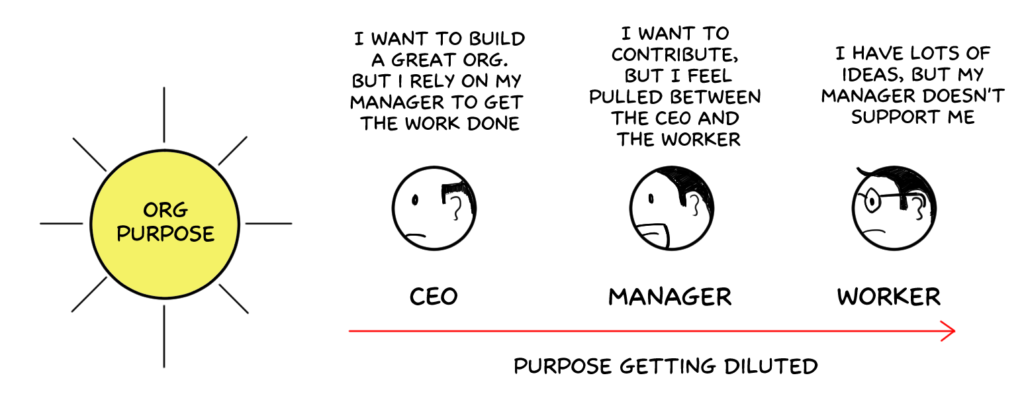
“In the 21st century, power is easier to get, harder to use — and easier
to lose.” ~ Moises Naim
In decades past, people believed in the magic of leadership.
A leader was considered to be an exalted individual born skills and talents that the rest of us lacked.
In more recent times, the dominant paradigm shifted towards “learned leadership”. A slew of management texts flooded the market, intended to teach the skills to ascend to positions of leadership and successfully marshal the resources around you in service of your vision.
Today’s definition of leadership is evolving yet again.
In the face of growing complexity, countries, organizations and people are increasingly skeptical that “one leader,” no matter how skilled, could have a ready answer to every problem.
Instead, as more and more people gain access to platforms to share their thoughts and ideas, we are witnessing a democratization of power throughout the population of those who would previously have been relegated to the position of a “follower.”
The time has come for organizations to evolve their structure to allow for for power (and leadership) to be distributed throughout the organization.
Holacracy® is one such practice that is paving the way for a new model of leadership.
Holacracy — A Radical New Way of Running and Scaling Responsive Companies
Ever since Zappos embraced Holacracy, a lot has been written about this new way to structure organizations.
Holacracy eliminates managers and middle men, as well as decision by consensus or by manager approval.
In short, it breaks every rule of the conventional management hierarchy. .
Believe it or not, though, Holacracy is NOT leaderless, structureless anarchy.
In fact, you’ll find more explicit accountabilities, transparency, and rules in a Holacracy-powered organization than in the “command and control” organizations we’ve been operating with in almost a century.
When Bosses Leave, Leadership Thrives
When an organization adopts the practice of Holacracy, the CEO signs his power into the Holacracy Constitution. It’s a document with the core rules, structure, and processes of the Holacracy practice for governing and managing an organization. Click here to read the constitution.
This a meaningful gesture that turns the organization’s highest leader into a team member. In turn, the Constitution replaces the CEO as the new “boss” of the organization.
In a management hierarchy, the organization’s purpose often gets diluted:

With Holacracy in place, each team member can plug directly into the driving force of the organization’s purpose:

If you wake up tomorrow and find out that your company has adopted Holacracy, here is what you can expect:
You’ll check the priorities of your team (set by the Lead Link of your circle) and then you’ll take a look at the priorities you’ve set yourself in response to the Lead Link’s strategy.
Since the purpose (or the long term goals) of your roles, team, and organization are your new “boss”, you are in fact free to say “NO” to any task that comes you way if does not align with the purpose of the roles that you fill.
…Even if the request is made by your (now ex) CEO…. Let that sink in!
When you go to meetings, you don’t have to tap dance your way around your problems. In a Holacracy-powered organization, each and every team member gets the chance to raise tensions, request actions and outcomes of their colleagues, and make meaningful decisions in their roles.
FUN FACT: People can’t reject your requests — — unless, that’s right — — they are are outside of the scope of the purpose of their roles
Last but not the least, you are not your position in the hierarchy.
You are the steward of your roles. And you have the freedom to do anything you wish to serve the purpose of role as long as you aren’t breaking the explicit (written down) rules outlined in your organization’s governance records or the rules of the Holacracy Constitution.
In a management hierarchy: Bosses lead people

With Holacracy: People lead roles

In such a setting, a couple of things happen:
– Everyone is a leader. Team members lead their own roles, rather than a few designated leaders (managers) guiding the actions of a group of followers (employees).. The perceptions of team members are shaped by each individual’s contributions, rather than through their position.
– Creativity and accountability go through the roof. If someone has an idea to further organizational purpose, there is no need for approval or consensus. Holacracy removes the roadblocks between good ideas and execution.
– Since people generally fill a variety of roles, they are not restricted to serving only one department or aspect of the organization. With the right skills, a writer can also be a software developer. And vice versa.
This increased sense of autonomy, creativity, and flexibility allows individuals to express themselves more completely and “show up” as a whole person, without holding anything back.
Leadership, in Holacracy-powered environments, is not considered to be a personal attribute. Instead, it is available to anyone who chooses to take action to serve the interest of the organization.
In and today’s agile world, change is the only constant.
Holacracy makes it possible for individuals to act as leaders and drive innovation, without confronting the barriers of politics, bureaucracy, or management bottlenecks.
Here are some resources to get started with Holacracy
Holacracy Book by Brian Robertson, co-founder of Holacracy. This is a comprehensive book and enough to get started with Holacracy. Foreword by David Allen.
💬 Follow me on Twitter for more insights on productivity, GTD, and self-management.
I believe our work should be an expression of our most creative selves. I work with business owners and their teams to achieve stress-free productivity.

